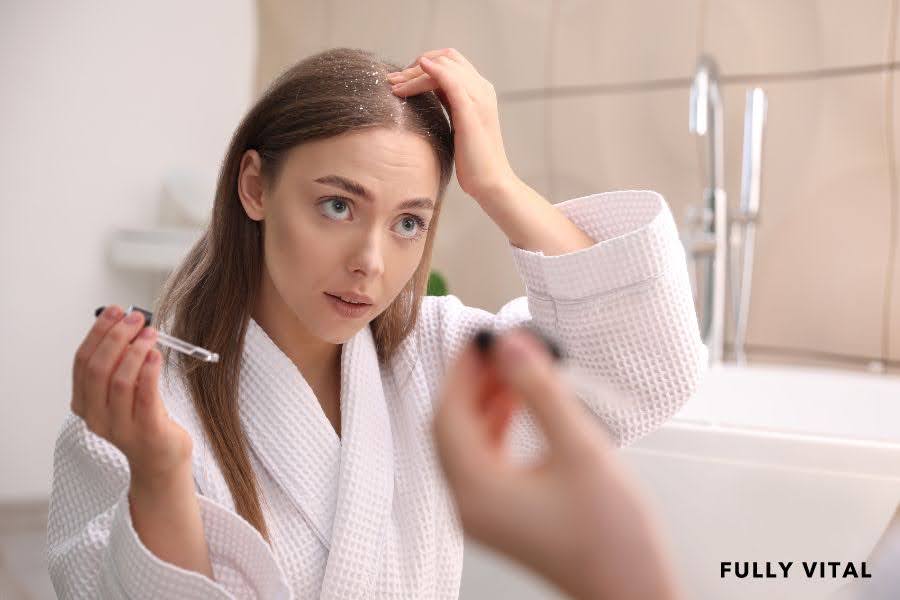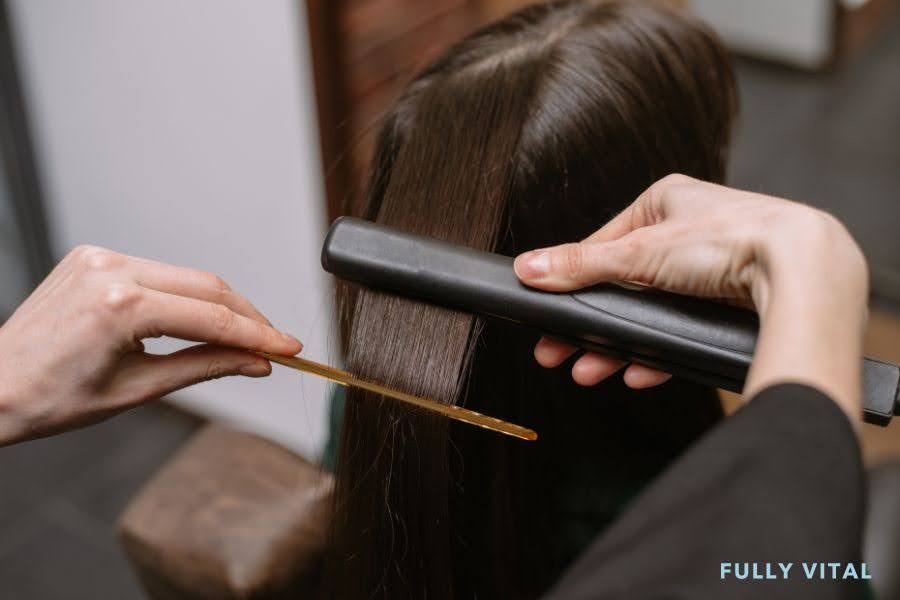
Hat Hair Horror: Separating Fact From Fiction On Hair Loss
Hey beautiful ladies!
Let's chat about a common worry - does wearing hats cause hair loss?
It's a big myth out there, and I've done some digging to find the truth for us.
So, sit back, relax with your favorite drink, and let's uncover the facts about hats and hair health.
And hey, don't forget to check out Fully Vital's hair growth products.
They're amazing for keeping our hair strong and gorgeous!

I LOVE MY HAIR NOW
FullyVital hair serum and hair vitamins made tremendous improvements in my hair. I truly love my hair now.
Dorit S.,
What Is Hair Loss?
Hair loss, also known as alopecia, is the partial or complete loss of hair, which can significantly impact an individual's self-esteem and psychological well-being.
It can be caused by a variety of factors including genetics, hormonal changes, medical conditions, and stress, each contributing differently to the severity and pattern of hair loss.
Contrary to popular belief, wearing a hat does not directly cause hair loss; this is a common misconception that oversimplifies the complex nature of alopecia.
Instead, hair loss is primarily influenced by internal factors such as genetics and hormonal imbalances, which play a more significant role in determining hair health.
External factors like environmental stressors and nutritional deficiencies can also contribute to hair loss, though their impact varies among individuals.
While certain hairstyles and treatments may contribute to hair damage, the act of wearing a hat alone is not a significant factor in hair loss.
At Fully Vital, we aim to debunk myths surrounding hair loss and provide effective solutions to help stimulate hair growth, focusing on a holistic approach that addresses both internal and external factors affecting hair health.
Myths And Facts About Hair Loss
There are many myths surrounding hair loss, and it's important to separate fact from fiction.
Let's take a closer look at some common myths and the truth behind them:
Myth: Wearing A Hat Causes Hair Loss.
- Fact: Wearing a hat does not directly lead to hair loss. Hair loss is predominantly influenced by internal factors such as genetics and hormonal changes.1 While wearing a tight hat over a prolonged period may cause temporary hair breakage, it does not result in permanent hair loss.2
Myth: Brushing Your Hair Frequently Can Prevent Hair Loss.
- Fact: Excessive brushing can actually contribute to hair damage and breakage.3 While gentle brushing can help distribute natural oils and stimulate the scalp, aggressive brushing can cause hair breakage, especially when the hair is wet and more vulnerable.
Myth: Coloring And Styling Your Hair Causes Hair Loss.
- Fact: Temporary hair breakage can occur with excessive chemical treatments and heat styling, but it doesn't necessarily lead to permanent hair loss. Using hair care products specifically designed to protect and nourish your locks can help minimize damage caused by coloring and styling.

How Wearing A Hat Could Cause Hair Loss: Theories And Evidence
Wearing a hat is a common practice for various reasons, ranging from fashion choices to protection from the elements.
However, there's a lingering concern about whether this habit could lead to hair loss.
It's crucial to understand that while wearing a hat does not directly cause permanent hair loss, certain ways of wearing hats could potentially contribute to temporary hair issues, particularly in terms of hair breakage.
One of the primary theories revolves around traction alopecia.
This type of hair loss occurs due to constant tension and pulling on the hair follicles.
It's commonly seen in individuals who frequently wear tight hats, headbands, or other headgear that exerts significant pressure on the scalp.
The constant pulling can weaken hair follicles, leading to hair breakage or loss in those areas.
Traction alopecia is particularly concerning because it can become more severe over time if the pulling continues.
However, it's important to note that this type of hair loss is usually reversible.
Once the excessive tension on the hair is removed, and the scalp is given time to recover, hair growth can return to normal.
Types Of Hats And Their Impact On Scalp Health
When it comes to choosing the right hat, certain styles may have a different impact on your scalp health.
Here are some common types of hats and their effects on your lovely locks:
Tight-Fitting Hats
Hats that are too tight can cause excessive tension on your hair follicles, potentially leading to temporary hair breakage.
Opt for hats with adjustable straps or elastic bands to ensure a comfortable fit without causing unnecessary scalp pressure.
Synthetic Fabric Hats
Hats made from synthetic materials may not allow proper airflow to the scalp, leading to sweat and moisture buildup.
This can create an environment conducive to scalp issues such as itchiness and dandruff.
Consider choosing hats made from breathable, natural fabrics like cotton or bamboo to promote scalp health.
Wide-Brimmed Hats
While these hats offer excellent sun protection for your hair and scalp, they can also cause sweat and oil buildup, especially during warmer weather.
To maintain scalp health, consider choosing wide-brimmed hats with sweat-wicking or breathable features to prevent moisture accumulation.

Role Of Hygiene In Hat Usage And Hair Health
Maintaining good hygiene practices is crucial when it comes to hat usage, particularly if you're concerned about promoting healthy hair growth and preventing scalp issues.
This involves not only taking care of your hair and scalp but also ensuring that your hats are clean and well-maintained.
Firstly, it's important to regularly clean your hats.
This is especially true for hats worn during physical activities or in warm, humid environments where sweat and oils are more likely to accumulate.
Over time, the buildup of sweat, dirt, and oils on the hat's fabric can create an environment that may irritate the scalp or even lead to infections.
This is why hats with removable and washable sweatbands or linings are a great choice.
They allow for easier and more thorough cleaning, ensuring that any accumulated sweat and dirt can be effectively removed.
Regular washing of these components not only keeps the hat clean but also extends its lifespan.
Discover The Key Features And Benefits Of Fully Vital's Hair Growth ProductsAt Fully Vital, we understand the importance of maintaining healthy, vibrant hair. That's why we've developed a range of hair growth products that are scientifically formulated to combat the signs of aging and promote strong, luscious locks. Here are some of the key features and benefits of our products:
If you're ready to take control of your hair's health, take the first step with Fully Vital's hair growth products today! |
Final Thoughts On Hat Hair Horror: Separating Fact From Fiction On Hair Loss
In conclusion, wearing a hat does not directly cause permanent hair loss, but certain hat-wearing habits can contribute to temporary hair breakage.
By debunking myths and understanding the impact of hat styles on scalp health, we can make informed choices to maintain healthy hair growth while enjoying our favorite headwear.
At Fully Vital, our mission is to empower women to embrace their natural beauty by providing science-backed hair growth products that support overall hair health.
We encourage you to explore our range of products designed to nourish and revitalize your locks, so you can confidently wear any hat while showcasing your vibrant, healthy hair.
Remember to choose hats that offer a comfortable fit and are made from breathable, scalp-friendly materials.
Practice good hygiene by cleaning your hats regularly and maintaining a clean, healthy scalp.
By paying attention to these factors, you can continue to rock your favorite hats while keeping your gorgeous locks in top-notch condition.
Check out our recent blogs:
- Biotin For Hair: The Miracle Vitamin You Need In Your Beauty Routine
- Say Goodbye To Hair Damage: Proven Methods For Effective Repair
- The Science Behind Biotin And Hair Growth: How Much Do You Need?
Frequently Asked Questions About Hat Hair Horror: Separating Fact From Fiction On Hair Loss
Is there scientific evidence supporting the theory of hat-induced hair loss?
There is no scientific evidence that wearing a hat directly causes permanent hair loss.
However, certain types of hats and how they are worn can contribute to temporary hair loss or damage.
Can the type of hat you wear contribute to hair loss?
Yes, certain tight or traction-inducing hats can contribute to a condition known as traction alopecia, which is hair loss caused by constant pulling or tension on the hair follicles.
What is traction alopecia?
Traction alopecia is a form of hair loss caused by physical stress and tension on the hair follicles.
It is often associated with hairstyles that pull on the hair, but certain hats can also contribute to this condition.
Can tight hats cause traction alopecia?
Yes, tight hats can cause traction alopecia by constantly pulling on the hair follicles, leading to hair loss around the areas of tension.
Does the material of the hat matter in hair loss?
The material of the hat can contribute to friction, which can lead to temporary hair loss.
Hats made from materials with rough or abrasive textures can potentially cause more friction and hair damage.
How does friction contribute to hair loss?
Friction from certain materials and the constant rubbing of the hat against the hair can weaken the hair shaft, leading to breakage and hair loss.
This condition is referred to as frictional alopecia.
What is frictional alopecia?
Frictional alopecia is hair loss caused by friction and repeated rubbing of the hair, often due to wearing certain types of hats or headgear.
Is hair loss from hats permanent?
In most cases, hair loss from hats is not permanent and can be reversed with proper care and adjustments to hat-wearing habits.
What are some ways to prevent hat hair?
To prevent hat-induced hair damage, consider choosing hats made from softer materials, wearing the hat loosely, and taking breaks from wearing hats to reduce tension on the hair.
Can conditioning your hair prevent hair loss from hats?
Regular conditioning and keeping the hair moisturized can help minimize potential hair damage from wearing hats.
Conditioning can help reduce friction and strengthen the hair, making it less susceptible to breakage.
Sources:
- Ramos, P. M., & Miot, H. A. (2015). Female Pattern Hair Loss: a clinical and pathophysiological review. Anais Brasileiros de Dermatologia, 90(4), 529–543. https://doi.org/10.1590/abd1806-4841.20153370
- Phillips, T. G., Slomiany, W. P., & Allison, R. (2017). Hair Loss: Common Causes and Treatment. American Family Physician, 96(6), 371–378. https://www.aafp.org/pubs/afp/issues/2017/0915/p371.html?fd=5317710456904024
- KLIGMAN, A. M. (1961). Pathologic Dynamics of Human Hair Loss. Archives of Dermatology, 83(2), 175. https://doi.org/10.1001/archderm.1961.01580080005001







